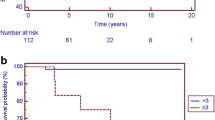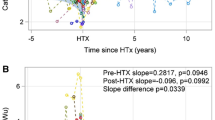Abstract
Pediatric patients with hypertrophic cardiomyopathy (HCM) and restrictive physiology (RP) with poor outcomes have been identified, but data on their course are limited. Our goal was to delineate the clinical features and course of children with HCM and RP. An institutional review of 119 patients identified between 1985 and 2010 with the diagnosis of HCM was performed. The diagnosis of RP was based on >1 echocardiogram along with at least one of the following: left atrial enlargement without evidence of left ventricle dilation, E/E′ ratio ≥ 10, and E/A ratio ≥ 3. Outcomes analysis was performed using Cox or Poisson regression when appropriate. RP was present in 50 (42%) patients. In patients without RP, 10-year freedom-from-death or aborted sudden cardiac death (aSCD), and death or heart transplant (HT), were 93.6 and 98.5%, respectively. In patients with RP, 10-year freedom-from-death or aSCD, and death or HT, were 59.0 and 71.2%, respectively. RP conferred a 3.5-fold increase in incidence rate of hospitalization (P = 0.01), a 3.8-fold increase in hazard of death or aSCD (P = 0.02), and a 5.7-fold increase in hazard of death or HT (P = 0.04). Assessment for RP is of paramount importance in children with HCM because those without RP have a good prognosis, and those with RP account for the majority of poor outcomes.



Similar content being viewed by others
References
Appleton CP, Hatle LK, Popp RL (1988) Demonstration of restrictive ventricular physiology by Doppler echocardiography. J Am Coll Cardiol 11(4):757–768
Appleton CP, Hatle LK, Popp RL (1988) Relation of transmitral flow velocity patterns to left ventricular diastolic function: new insights from a combined hemodynamic and Doppler echocardiographic study. J Am Coll Cardiol 12(2):426–440
Biagini E, Spirito P, Rocchi G, Ferlito M, Rosmini S, Lai F et al (2009) Prognostic implications of the Doppler restrictive filling pattern in hypertrophic cardiomyopathy. Am J Cardiol 104(12):1727–1731
Border WL, Michelfelder EC, Glascock BJ, Witt SA, Spicer RL, Beekman RH III et al (2003) Color M-mode and Doppler tissue evaluation of diastolic function in children: Simultaneous correlation with invasive indices. J Am Soc Echocardiogr 16(9):988–994
Brown OR, Harrison DC, Popp RL (1974) An improved method for echographic detection of left atrial enlargement. Circulation 50(1):58–64
Calvet D, Touze E, Varenne O, Sablayrolles JL, Weber S, Mas JL (2010) Prevalence of asymptomatic coronary artery disease in ischemic stroke patients: the PRECORIS study. Circulation 121(14):1623–1629
Choong CY, Abascal VM, Thomas JD, Guerrero JL, McGlew S, Weyman AE (1988) Combined influence of ventricular loading and relaxation on the transmitral flow velocity profile in dogs measured by Doppler echocardiography. Circulation 78(3):672–683
Choong CY, Herrmann HC, Weyman AE, Fifer MA (1987) Preload dependence of Doppler-derived indexes of left ventricular diastolic function in humans. J Am Coll Cardiol 10(4):800–808
Colan SD, Lipshultz SE, Lowe AM, Sleeper LA, Messere J, Cox GF et al (2007) Epidemiology and cause-specific outcome of hypertrophic cardiomyopathy in children: findings from the Pediatric Cardiomyopathy Registry. Circulation 115(6):773–781
Decker JA, Rossano JW, Smith EO, Cannon B, Clunie SK, Gates C et al (2009) Risk factors and mode of death in isolated hypertrophic cardiomyopathy in children. J Am Coll Cardiol 54(3):250–254
Efthimiadis GK, Giannakoulas G, Parcharidou DG, Karvounis HI, Mochlas ST, Styliadis IH et al (2007) Clinical significance of tissue Doppler imaging in patients with hypertrophic cardiomyopathy. Circ J 71(6):897–903
Elliott PM, Gimeno Blanes JR, Mahon NG, Poloniecki JD, McKenna WJ (2001) Relation between severity of left-ventricular hypertrophy and prognosis in patients with hypertrophic cardiomyopathy. Lancet 357(9254):420–424
Elliott PM, Poloniecki J, Dickie S, Sharma S, Monserrat L, Varnava A et al (2000) Sudden death in hypertrophic cardiomyopathy: identification of high risk patients. J Am Coll Cardiol 36(7):2212–2218
Iyer P, Evans N (1996) Re-evaluation of the left atrial to aortic root ratio as a marker of patent ductus arteriosus. Arch Dis Child Fetal Neonatal 70(2):F112–F117
Kirk R, Edwards LB, Kucheryavaya AY, Aurora P, Christie JD, Dobbels F et al (2010) The Registry of the International Society for Heart and Lung Transplantation: thirteenth official pediatric heart transplantation report―2010. J Heart Lung Transplant 29(10):1119–1128
Kjaergaard J, Johnson BD, Pellikka PA, Cha SS, Oh JK, Ommen SR (2005) Left atrial index is a predictor of exercise capacity in patients with hypertrophic cardiomyopathy. J Am Soc Echocardiogr 18(12):1373–1380
Lester LA, Vitullo D, Sodt P, Hutcheon N, Arcilla R (1979) An evaluation of the left atrial/aortic root ratio in children with ventricular septal defect. Circulation 60(2):364–372
Maron BJ (2010) Contemporary insights and strategies for risk stratification and prevention of sudden death in hypertrophic cardiomyopathy. Circulation 121(3):445–456
Maron BJ (2002) Hypertrophic cardiomyopathy: a systematic review. JAMA 287(10):1308–1320
Maron BJ, Casey SA, Poliac LC, Gohman TE, Almquist AK, Aeppli DM (1999) Clinical course of hypertrophic cardiomyopathy in a regional United States cohort. JAMA 281(7):650–655
Maron BJ, Gardin JM, Flack JM, Gidding SS, Kurosaki TT, Bild DE (1995) Prevalence of hypertrophic cardiomyopathy in a general population of young adults. Echocardiographic analysis of 4111 subjects in the CARDIA Study. Coronary Artery Risk Development in (Young) Adults. Circulation 92(4):785–789
Maron BJ, Olivotto I, Spirito P, Casey SA, Bellone P, Gohman TE et al (2000) Epidemiology of hypertrophic cardiomyopathy-related death: revisited in a large non-referral-based patient population. Circulation 102(8):858–864
Maron BJ, Spirito P, Wesley Y, Arce J (1986) Development and progression of left ventricular hypertrophy in children with hypertrophic cardiomyopathy. N Engl J Med 315(10):610–614
Matsumura Y, Elliott PM, Virdee MS, Sorajja P, Doi Y, McKenna WJ (2002) Left ventricular diastolic function assessed using Doppler tissue imaging in patients with hypertrophic cardiomyopathy: relation to symptoms and exercise capacity. Heart 87(3):247–251
McMahon CJ, Nagueh SF, Pignatelli RH, Denfield SW, Dreyer WJ, Price JF et al (2004) Characterization of left ventricular diastolic function by tissue Doppler imaging and clinical status in children with hypertrophic cardiomyopathy. Circulation 109(14):1756–1762
Menon SC, Ackerman MJ, Cetta F, O’Leary PW, Eidem BW (2008) Significance of left atrial volume in patients <20 years of age with hypertrophic cardiomyopathy. Am J Cardiol 102(10):1390–1393
Nagueh SF, Appleton CP, Gillebert TC, Marino PN, Oh JK, Smiseth OA et al (2009) Recommendations for the evaluation of left ventricular diastolic function by echocardiography. J Am Soc Echocardiogr 22(2):107–133
Nistri S, Olivotto I, Betocchi S, Losi MA, Valsecchi G, Pinamonti B et al (2006) Prognostic significance of left atrial size in patients with hypertrophic cardiomyopathy (from the Italian Registry for Hypertrophic Cardiomyopathy). Am J Cardiol 98(7):960–965
Olivotto I, Maron BJ, Montereggi A, Mazzuoli F, Dolara A, Cecchi F (1999) Prognostic value of systemic blood pressure response during exercise in a community-based patient population with hypertrophic cardiomyopathy. J Am Coll Cardiol 33(7):2044–2051
Russo LM, Webber SA (2005) Idiopathic restrictive cardiomyopathy in children. Heart 91(9):1199–1202
Sadoul N, de Chillou C, Aliot E, McKenna WJ (1999) Evaluation of the risk of sudden death in hypertrophic cardiomyopathy. Arch Mal Coeur Vaiss 92(Spec no 1):65–73
Spirito P, Bellone P, Harris KM, Bernabo P, Bruzzi P, Maron BJ (2000) Magnitude of left ventricular hypertrophy and risk of sudden death in hypertrophic cardiomyopathy. N Engl J Med 342(24):1778–1785
Stoddard MF, Pearson AC, Kern MJ, Ratcliff J, Mrosek DG, Labovitz AJ (1989) Left ventricular diastolic function: comparison of pulsed Doppler echocardiographic and hemodynamic indexes in subjects with and without coronary artery disease. J Am Coll Cardiol 13(2):327–336
Taggart NW, Cetta F, O’Leary PW, Seward JB, Eidem BW (2010) Left atrial volume in children without heart disease and in those with ventricular septal defect or patent ductus arteriosus or hypertrophic cardiomyopathy. Am J Cardiol 106(10):1500–1504
Varnava AM, Elliott PM, Mahon N, Davies MJ, McKenna WJ (2001) Relation between myocyte disarray and outcome in hypertrophic cardiomyopathy. Am J Cardiol 88(3):275–279
Author information
Authors and Affiliations
Corresponding author
Rights and permissions
About this article
Cite this article
Maskatia, S.A., Decker, J.A., Spinner, J.A. et al. Restrictive Physiology is Associated With Poor Outcomes in Children With Hypertrophic Cardiomyopathy. Pediatr Cardiol 33, 141–149 (2012). https://doi.org/10.1007/s00246-011-0106-6
Received:
Accepted:
Published:
Issue Date:
DOI: https://doi.org/10.1007/s00246-011-0106-6




